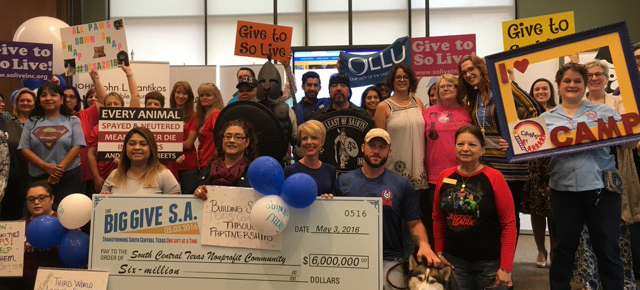
Bringing in diverse donors: Lessons from San Antonio’s giving day
Photo by The Big Give S.A.
A new Knight Foundation report on Giving Days found that while these online giving campaigns were successful in bringing in new donors to nonprofits, the donor pool is overwhelmingly white, highly educated and female. Below, John Burnham, a consultant who helps lead San Antonio’s Big Give S.A., writes about the campaign’s efforts to reach more Hispanics.
Over the past three years, The Nonprofit Council and The San Antonio Area Foundation have partnered together to put on the Big Give S.A., the 24-hour online give day for San Antonio and the surrounding 14 counties.
While we’ve had a lot of success bringing first-time donors to the table – growing from 41 percent in 2014 to 50 percent in 2016 – our demographic data from our first two years demonstrated that the platform usership wasn’t as diverse as we would have hoped (being 78 percent female, 66 percent white in 2015), reflecting the data in Knight’s new report.
As one of the largest minority majority regions in the country, South Central Texas should be leading the way in bringing new voices to the philanthropic table while creating an event that is equitable and welcoming to everyone. As a day meant to celebrate charity, our goal is to use the Big Give S.A. as a way to bring the entire community together.
While there is no magic bullet, this past year, the Big Give S.A. implemented three new tactics to try to make the event more inviting for minority donors. Here’s what we tried:
1.) Bilingual content and marketing
With one of the largest Spanish speaking populations in the country, we needed to provide content in a manner that increased accessibility for everyone. For a city with San Antonio’s demographics, this meant producing a fully functioning Spanish-language site and advertisements.
Tapping into local, philanthropically-minded companies, we partnered with Santikos Entertainment and Univision to run video and radio spots on air and in concentrated local theatres before the screening of major movies.
2.) Training nonprofits on how to market to members of the Hispanic Community
As is the case with most small nonprofits across the country, many of the agencies in South Central Texas rely on a small subsection of the region to fund their programs. In an effort to help expand agency reach, increase sustainability and equip nonprofits with the tools needed to grow their base of supporters, we brought in consultants from across the country to train agencies on cross-market communications and outreach to Hispanic communities.
In particular, we focused on the nuances and differences in giving between first and second-generation Hispanic and Latino communities, and how they use social media.
3.) Linking donations to demographic information
In an effort to better identify giving patterns we linked our donor demographic survey to gifts, enabling us to get a better sense of how subsets of our region give. With this information, we have been able to create links between causes and donors that will help us better tailor the language we use, the messaging we target donors with, and the information we can provide our nonprofit participants.
By measuring giving trends within our community, we can better predict the way the community will give in the future while employing new tactics to hopefully make the give day more appealing to everyone.
While we were hoping that these strategies would lead to a definitive improvement in our ability to connect new donors to the causes that matter most to them, ultimately with the system-wide crash during Give Local America, our data was skewed.
With that being said, based on our survey results from nearly nine percent of donors, we did see a two percent shift in giving percentages with the share of those who self-identified as white decreasing to 64 percent and those who self-identified as Hispanic increasing by two percent to 27.5 percent.
Regardless of the successes and failure of this past year’s event, we think the strategies above are an important part of increasing philanthropy in the community and we plan to implement them again this year along with exploring more grassroots efforts like creating community taskforces to help spread the word about giving.
Reversing trends in philanthropy and bringing more voices to the table will require long-term solutions and ongoing conversations. We feel strongly that as an organization we need to better understand how and why people give so that we can do a better job connecting them with the wealth of agencies participating in the Big Give S.A.
John Burnam is principal of Burnam Gray, a San Antonio-based firm that helps lead the Big Give S.A.
Recent Content
-
Community Impactarticle ·
-
Community Impactarticle ·
-
Community Impactarticle ·


